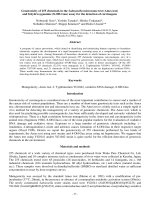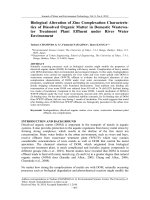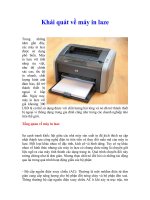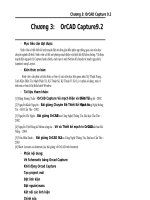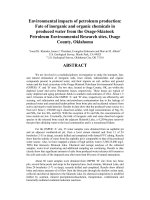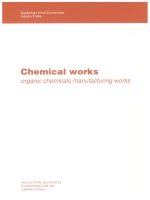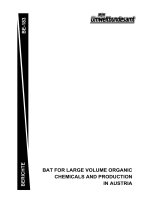Synthetic Organic Chemicals in Biosolids pptx
Bạn đang xem bản rút gọn của tài liệu. Xem và tải ngay bản đầy đủ của tài liệu tại đây (154.91 KB, 9 trang )
C. Henry, UWB Understanding Biosolids 1/05
7.1
Chapter 7 Synthetic Organic Chemicals in Biosolids
Society produces and consumes immense quantities of organic chemicals. Synthetic
organic chemicals are made in the laboratory and as by-products of manufacturing,
burning, or other human activities. “Organic” once described anything that was
originally living matter; in the scientific world, however, any substance containing
carbon molecules is organic. Here, synthetic organic chemicals are referred to simply as
organics to distinguish them from organic matter derived from plants and animals.
Natural processes do not create organics of general environmental concern.
The differences between organics and trace metals are important. In particular,
concentrations of organics are extremely low in biosolids – industrial pretreatment and
household hazardous waste programs are working well. Metals can be measured at 10
to 1000s of parts per million (ppm, 10-1000s of mg/kg), but organics seldom reach
concentrations of 1 ppm and often are either below detection levels or measured in the
parts per trillion (ppt) range. Their toxic potential in biosolids is thus remote, even
though they are far more toxic than metals at similar concentrations. A few of the more
common organics are listed in Table 7.1, and some are present in biosolids because
households and industries continue to discharge minute amounts as sewage.
The levels of organics are very low in biosolids for two reasons. First, increased
awareness of their dangers has led to regulations eliminating persistent ones in favor of
others that are more easily degraded. Second, many organics are volatile. Compounds
such as benzene, trichloroethylene, and chloroform are lost to the atmosphere in sewers
and aeration basins of wastewater treatment facilities. Also, unlike metals, organics
degrade with time. Some degrade very slowly, but many of the most persistent are no
longer produced (e.g., polychlorinated biphenyls PCBs once commonly used in
transformers). Because current organics are designed to degrade relatively quickly,
they do not linger in the environment. PCBs are no longer made, so their
concentrations in sewage and the environment continue to decline, as do those of
pesticides and herbicides such as DDT, dieldrin, eldrin, and 2,4,5-T.
C. Henry, UWB Understanding Biosolids 1/05
7.2
Table 7.1. Examples of synthetic organic compounds and their origin (taken from NRC 2003).
Class Origin Examples
Polycyclic aromatic
hydrocarbons (PAHs)
Naphthalene
Phenanthrene
Benzo[a]pyrene
Pyrene
Combustion of coal, oil, and wood
Asphalt, creosote
Automobile emissions, fuels, and
lubricating oils
Nitroaromatics
2,4,6-trinitrotoluene (TNT)
Trifluralin
Benefin
Ethalfluralin
Methyl parathion
Military installations
Bombing ranges
Bactericides
Pesticides
Phenols, anilines
Pentachlorophenol (PCP)
Phenylamide herbicides:
phenylureas,
phenylcarbamates,
and acylanilides
Wood preservatives
Biocides
Dyestuff wastewater
Phenylamide herbicides
Halogenated
aromatics
Polychlorinated biphenyls
(PCBs)
Dioxins
Hydraulic oils, capacitor dielectrics
Pesticide applications
Incineration of medical/municipal waste,
hazardous waste, and sewage sludge
Forest fires and volcanic eruptions
Cement kilns and boilers
Petroleum, coal, and tire combustion
Draft black liquor boilers
Secondary lead smelting
Halogenated
aliphatics
Chloroform
Bromomethane
Carbon tetrachloride
Vinyl chloride
1,1-dichloroethene
Trichloroethene (TCE)
Tetrachloroethene (PCE)
Degreasing solvents
Former dry-cleaning facilities
Plastics manufacturing
Pesticides and
herbicides
Alachlor
Aldicarb
Atrazine
BHC
Carbofuran
Chlordane
2,4-D
Toxaphene
DDT (DDD, DDE)
Agriculture
Residential and industrial pest control
Petroleum
hydrocarbons
Benzene
Xylenes
Toluene
Ethylbenzene
Alkanes
Oil recovery and refining industry
Automobiles and other forms of
transportation
Oil tankers, pipelines, and other modes of
transporting oil
Industry
C. Henry, UWB Understanding Biosolids 1/05
7.3
Synthetic organics have numerous origins, such as the phthalates used as binders in
plastics, which are so ubiquitous that inevitably some gets into wastewater. Similarly,
the most important source of dioxins is the textile industry, which uses dyes containing
dioxin. These dyes wash out of fabrics in laundering; however, dioxin levels are far
lower in newer fabrics, so wastewater dioxin levels are declining.
Degradation of synthetic organics
Most organics break down in wastewater treatment and continue to do so after they
are applied to land. When a compound decomposes it breaks into molecularly smaller,
more innocuous compounds by one or more of three different processes:
photochemical, chemical, and biological.
The photochemical process involves the energy of light, usually from the sun. In
some cases this energy is sufficient to break a molecule; an example is the effect of
sunlight on certain plastics, which may discolor, crack, and lose strength. A similar
process – chemical decomposition – takes place when other chemicals react with a
compound, resulting in breakdown of the organic molecules into simpler compounds
usually having different, less toxic chemical properties than the original, more complex
molecules.
Biological degradation is by far the most common natural process attacking these
chemicals. Biodegradation involves microorganisms such as bacteria and fungi
naturally living in soils; they are part of the soil’s ecosystem and are necessary for its
overall health. These microorganisms break down organic compounds for energy; in so
doing they literally consume organic pollutants, ultimately reducing them to carbon
dioxide, water, and methane. As synthetic organics are spilled, deposited, or otherwise
used in the environment, microorganisms have adapted to degrade them in exchange
for energy; for example, strains of bacteria have evolved to degrade PCBs and dioxins
(Pearce 1994).
Many factors influence the amount of biodegradation taking place in soils: absence
or presence of oxygen, pH (or acidity), amounts of other necessary nutrients available to
microorganisms (e.g., nitrogen, phosphorus, potassium), and whether the structures
and types of compounds are amenable to biodegradation. Complex chemicals are more
C. Henry, UWB Understanding Biosolids 1/05
7.4
difficult for soil microbes to degrade and thus remain in the environment longer. Two
are important to consider: PCBs and dioxin.
Contaminant entry into an organism
Any synthetic organics in the soil are potentially invasive and, once inside an
organism, may be toxic. However, not all organics can invade nor are they all harmful.
Active chemicals capable of direct impact are termed bioavailable. Each step a
contaminant must take to cause harm has a different bioavailability. A contaminant
bound to a soil particle can invade an organism only by direct ingestion of soil; once
ingested, only a very small portion is available and the remainder passes through and is
eliminated.
In contrast, a contaminant that has been released from a soil particle can enter an
organism by direct ingestion, plant uptake followed by consumption of the plant,
leaching into water that is then consumed, or inhalation after volatilization. Once in an
organism, a contaminant likely is bioavailable and may accumulate to toxic levels, even
though much of it may still be eliminated.
The fate of PCBs and dioxins
PCBs are found occasionally in biosolids, although in ever-decreasing
concentrations. Industry has curtailed their manufacture, but some are still present in
the urban environment in older electrical equipment and in industrial outputs; because
they are persistent, measurable quantities are sometimes found in sewers and biosolids.
In the National Sewage Sludge Survey conducted in 1988-1989, four of the different PCB
compounds were absent from all 198 biosolids wastewater treatment plants sampled;
low concentrations of the other three PCB compounds were present in only 10% of the
treatment plants.
Dioxins and furans are general names of two classes of synthetic organic compounds
called polyhalogenated aromatic hydrocarbons (PCDD/Fs). They are found
everywhere in the environment – water, soil, and air – principally as byproducts of
other processes, such as PCB synthesis, bleaching wood pulp, diesel fuel, burning
materials like wood that has chloride in it and municipal waste even forest fires and
C. Henry, UWB Understanding Biosolids 1/05
7.5
volcanic eruptions. Once airborne, they disperse readily and are re-deposited on the
soil and water. Many manufacturing processes that inadvertently created dioxins have
been changed or eliminated to reduce their incidence.
There are 210 different compounds (called congeners) making up these classes,
distinguished by the number of chlorine atoms each has and how the atoms are
arranged around the eight positions available. Seventeen are considered toxic, and
those 17 vary in toxicity. Toxic equivalents (TEQs) were devised to compare
concentrations of these compounds. The concentration of a particular compound is
multiplied by how toxic it is compared to the most toxic congener (2,3,7,8 TCDD). All
the compounds are then be added together to yield a single TEQ value.
Recent analysis of biosolids from several US wastewater treatment plants showed
ranges of 6 to 3600 pg/g TEQ (a picogram/g equals 1 g in 1,000,000,000,000 g of dry
biosolids, or 1 part per trillion), although half the samples tested were below 15 pg/g
TEQ. As with other toxic organics, these concentrations have decreased from their
peaks in the 1950s. For example, archived biosolids show concentrations peaked in
1956 (Sewart et al. 1995), decreasing to near-background levels in 1992.
Concentration of dioxins in biosolids (parts per trillion)
Year 1942 1944 1949 1953 1956 1958 1960 1992
Conc 18 36 61 127 402 229 166 0.4-29
Both PCBs and PCDD/Fs are potent carcinogens. For this reason, PCBs have long
been the focus of studies of organics in biosolids (MMSD 1988, Furr et al. 1976, Moza et
al. 1979), while investigations of dioxins and their behavior in biosolids and soils are
more recent. However, the majority of studies on the fate of PCBs and dioxins have
centered on sites with far higher levels of these compounds than are present in
biosolids. The results thus reflect a situation that exaggerates their overall
concentration and behavior when compared to actual concentrations in biosolids
intended for land application.
Soils and plants. In most cases, PCDD/F and PCB concentrations in biosolids are
higher than those in soils. Repeated applications can increase the soil concentration, but
very slowly. At a median concentration of PCDD/F of 15 pg/g and with a yearly
C. Henry, UWB Understanding Biosolids 1/05
7.6
application of 3 dry tons per acre, the concentration in the top 6 inches of soil would still
be less than 1.0 pg/g after 100 years. The concentration stays so low after repeated
applications because some decomposes each year. The estimated half-life (the time it
takes half to decompose) of PCDD/F is 10-20 years. If a 15-year half-life is assumed,
91% remains after 1 year, 61% after 10 years, and only about 8% after 50 years. At these
relatively low concentrations, background levels in the soil profile may exceed the
amounts added; in fact, atmospheric deposition of PCDD/Fs typically adds more TEQs
than are added by biosolids amendments.
PCDD/Fs typically are highly adsorbed by soil organic matter, do not volatilize, and
are relatively insoluble in water all reasons why they decompose slowly and linger in
the soil (GAO 2002). Field studies have shown that these compounds remain in the soil
for many years, corroborating evidence of long half-lives. By contrast, volatile
compounds or those that decompose readily may decline to background levels in less
than a year.
Plant uptake of these compounds is minimal for the same reasons they do not
degrade. Very small amounts have been found in plants, other than by adherence of
soil particles to plant parts (e.g., peels of root crops) or water splashing soil particles
onto them (Chaney et al. 1996). Also, small amounts have been found in crops with oily
roots (e.g., carrots) (Muller et al. 1994). Most of the relevant research has been
conducted on soils contaminated by forms of these compounds more pure than those
found in biosolids where the compounds are far less available to plants due to strong
adsorption by organic matter. Plant uptake of PCBs applied to soils generally is also
very minimal; for example, only small percentages have been reported in agricultural
crops, although root crops may have concentrations higher than those of other crops
(Duarte-Davidson and Jones 1996). Plant uptake depends upon compound solubility, as
more soluble compounds are taken up more readily. In the case of PCBs and PCDD/Fs,
those with fewer chlorine atoms are more soluble and taken up more easily than those
with four or more chlorine atoms. (Compounds with fewer chlorine atoms are also less
toxic.)
Humans. Estimates of human exposure to PCDD/Fs are based almost solely on
food consumption. Infants have the highest estimated daily intake followed by
children, the major reason being the high daily milk consumption and low body weight
C. Henry, UWB Understanding Biosolids 1/05
7.7
of both groups. For the general US population, the EPA estimates that 62% of PCDD/F
intake is from meats, eggs, and fish, 35% from milk and dairy products, and 3% from
fruits and vegetables; however, all PCDD/F levels are in decline due to reduced
emissions.
A risk assessment study predicted total dioxin exposure to be 2.6 ppt per kilogram
per day, based on the very conservative parameter of someone whose food was entirely
derived from biosolids-amended soil (Jackson and Eduljee 1994). The limit in the
United Kingdom (where the study was made) is 10 ppt per kilogram per day.
According to this model and its assumptions, application of biosolids to agricultural
lands presents no significant health risk, and other studies report similar findings.
Despite the presence of some PCBs and dioxins in biosolids and their potential
migration into the food chain, current research has demonstrated that land application
of such biosolids poses no significant risk to humans who eat the resulting agricultural
crops (Jackson and Eduljee 1994).
Other animals. PCBs and PCDD/Fs from biosolids reach animals via plant uptake
followed by consumption, splashes of PCBs and PCDD/Fs on plant shoots followed by
ingestion, or direct ingestion of soil. Because plant uptake is minor, by far the most
important exposure pathway for grazing animals is direct ingestion of soil and biosolids
particles. Ingestion is a problem for grazers such as cattle, which regularly consume
soil along with plant matter. When cattle were given PCDD/Fs in their feed, only small
amounts were absorbed; feces and milk were important excretion routes about 20% of
that taken up by a cow was excreted in her milk (McLachlan 1990).
Studies on wildlife failed to find chemically induced health problems after heavy
applications of pulp and paper waste residuals to pine plantations and reclaimed mine
sites (McFadden et al. 1995). Biosolids with PCDD/F concentrations as high as 50-80
ppt TEQ were evaluated in studies that included several species of birds, small
mammals, and soil fauna. There were no bioaccumulations in rodents, insects, or
earthworms nor were levels detectable in fish, algae, and back-vegetation in a lake
receiving runoff.
C. Henry, UWB Understanding Biosolids 1/05
7.8
Regulations
When the EPA analyzed a large number of treatment plants in 1988-1989 (the
National Sewage Sludge Survey), the organics in biosolids were lower than expected,
especially compared to the 40-Cities survey done in the late 1970s (Table 7.2, note that
pollutant limits are in parts per million, while concentrations are in parts per trillion).
At that time, a policy decision was made to delete synthetic organics from biosolids
regulations because the risk was so insignificant. The reasoning for exempting organics
is as follows.
1. The pollutant has been banned from use, has restricted use, or is no longer being
manufactured for use in the US.
2. The pollutant was not detected in many of the biosolids (less than 5%) in the
National Sewage Sludge Survey.
3. The concentration of the pollutant in biosolids is already so low that, when
applied to soils, it would be less than that determined safe by the exposure risk
assessment.
Table 7.2. Chemical organics in biosolids evaluated for risk to humans and the environment (modified
from NAS 1996 and EPA 1995).
Pollutants Limiting pathway Pollutant limit 1970 Conc
1
1988 Conc
2
(ppm) (ppm) (ppt) (ppt)
Aldrin/Dieldrin adult eating animal products 2.7 6.4 (16%) 1.9 (3%)
Benzo(a)pyrene child eating biosolids 15 138 (21%) - (3%)
Chlordane child eating biosolids 86 6.4 (16%) - (0%)
DDT adult eating fish/drinking water 120 (0%) - (0%)
Heptachlor adult eating animal products 7.4 6.4 (16%) - (0%)
Hexachlorobenzene adult eating animal products 29 155 (16%) - (0%)
Hexachlorobutadiene adult eating animal products 600 23 (5%) - (0%)
Lindane child eating biosolids 84 6.4 (16%) - (0%)
Dimethylamine child eating biosolids 2.1 57 (5%) - (0%)
Toxaphene adult eating animal products 10 6.4 (16%) - (0%)
Trichloroethylene child eating biosolids 10000 8139 (84%) - (1%)
1
Averages from the 40-Cities Study conducted in the late 1970s.
2
Averages from the National Sewage Sludge Survey conducted in the late 1980s.
Numbers in parentheses are the percentage of wastewater treatment plants in which a compound was detected.
The EPA is now in the process of adding numeric concentration limits for PCDD/Fs
and PCBs in biosolids applied to land. As an example of the magnitude of
concentration limits that may be proposed, in 1994 the EPA entered into a
C. Henry, UWB Understanding Biosolids 1/05
7.9
Memorandum of Understanding with the pulp and paper industries (which at the time
had significant concentrations of dioxins in their residuals). This memorandum states
that residuals with less than 10 ppt TEQ would be unregulated; for those exceeding 10
ppt TEQ to a maximum concentration of 50 ppt TEQ, the soils to which waste residuals
were incorporated must not exceed 10 ppt TEQ in the soil/residual mixture.
Summary
Society produces large amounts of synthetic organic compounds. Because of
widespread use, some find their way into sewer systems, survive wastewater treatment,
and reappear in low concentrations in biosolids. In general concentrations are
extremely low and most organics eventually degrade.
In the rule-making process for biosolids, the EPA sought those organics that
presented the greatest risk to humans and the environment. An exposure risk
assessment indicated that concentrations in current biosolids were far below accepted
limits. In addition, concentrations of many organics in biosolids were dramatically
decreasing as the result of industrial pretreatment, household hazardous waste
programs, and halting production of the most toxic chemicals (such as PCBs). Synthetic
organics also pose little risk because they are difficult to assimilate. The main exposure
route for humans and other animals is by direct ingestion of soil containing biosolids or
consumption of fat from animals that ate soil. Plants take up insignificant amounts of
organics and those that are taken up are strongly adsorbed to soil particles, especially
by the organic fraction of biosolids. Studies have shown that PCBs and
dioxins/difurans pose little risk, despite their high toxicity.
